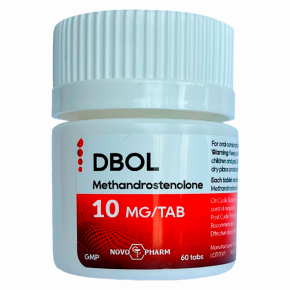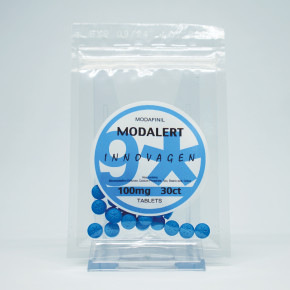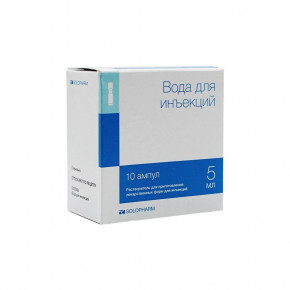Winstrol - Stanozolol
Winstrol is one of the well-known anabolic steroids, used to increase strength and endurance, to build a muscle mass and sculpt a perfect physique. Good addition to cutting cycle. 40-60mg/day 8-12 weeks
Winstrol is the most widely recognized trade name for the drug stanozolol. Stanozolol is a derivative of dihydrotestosterone, chemically altered so that the hormone’s anabolic (tissue-building) properties are greatly amplified and its androgenic activity minimized. Stanozolol is classified as an “anabolic” steroid and exhibits one of the strongest dissociations of anabolic to androgenic effect among commercially available agents. It also cannot be aromatized into estrogens. Stanozolol is the second most widely used oral steroid, succeeded in popularity only by Dianabol (methandrostenolone). It is favored for its ability to promote muscle growth without water-retention, making it highly valued by dieting bodybuilders and competitive athletes.
History
Stanozolol was first described in 1959.1 It was developed into a medicine by Winthrop Laboratories in Great Britain. Parent firm (Sterling) filed for U.S. patent on the agent in 1961. Stanozolol was officially released to the U.S. prescription drug market in 1962 under the brand name Winstrol. Stanozolol was initially prescribed for a variety of medical purposes, including the induction of appetite and lean tissue gain in cases of weight loss associated with many malignant and non-malignant diseases, the preservation of bone mass during osteoporosis, the promotion of linear growth in children with growth failure, as an anti-catabolic during prolonged corticosteroid therapy or for post-operative and post-trauma (burns, fractures) patients, and even to treat debility in the elderly.
The FDA’s control over the prescription drug market had tightened by the mid-1970s, and the indicated uses for Winstrol were soon narrowed. During this time the FDA officially supported that Winstrol was “Probably Effective” as an adjunct therapy for treating osteoporosis, and for promoting growth in pituitary-deficient dwarfism. With this position, Winthrop was given more time to sell and study the agent. Winthrop was able to continually satisfy the FDA regarding Winstrol’s validity as a therapeutic agent, and it remained in the U.S. throughout the 1980s and 1990s, a time when many other anabolic steroids were disappearing from the marketplace. Stanozolol was also showing some promise during this period for improving red blood cell concentrations, combating breast cancer, and (more recently) treating angioedema, a disorder characterized by the swelling of subdermal tissues, often with hereditary causes.
Winthrop went through a number of corporate changes during the 1990s, including a 1991 merger with Elf Sanofi to form Sanofi Winthrop. Sanofi Winthrop continued on to sell Winstrol in the U.S. for approximately 10 more years, before finally discontinuing the medication because of “manufacturing issues” (Searle was actually making the product for Sanofi at the time, and had reportedly ceased production). In 2003, the rights to Winstrol were officially transferred to Ovation Pharmaceuticals. Winstrol remains an approved drug on the U.S. pharmaceutical market, although is not under active production by the Ovation label. All forms of Winstrol are presently unavailable in the U.S., although the Winstrol brand remains available in Spain. Numerous other brands and generic forms of the drug are produced in other countries, in both human and veterinary drug markets.
How Supplied
Stanozolol is widely available in both human and veterinary drug markets. Composition and dosage may vary by country and manufacturer. Stanozolol was originally designed as an oral anabolic steroid, containing 2mg of drug per tablet (Winstrol). Other brands commonly contain 5 mg or 10 mg per tablet. Stanozolol can also be found in injectable preparations. These are the most commonly water-based suspensions carrying 50 mg/ml of steroid.
Structural Characteristics
Stanozolol is a modified form of dihydrotestosterone. It differs by 1) the addition of a methyl group at carbon 17-alpha to protect the hormone during oral administration and 2) the attachment of a pyrazole group to the A-ring, replacing the normal 3-keto group (this gives stanozolol the chemical classification of a heterocyclic steroid). When viewed in the light of 17-alpha methyl dihydrotestosterone, the A-ring modification on stanozolol seems to considerably increase its anabolic strength while reducing its relative androgenicity.
Stanozolol has a much weaker relative binding affinity for the androgen receptor than testosterone or dihydrotestosterone. At the same time, it displays a much longer half-life and lower affinity for serum binding proteins in comparison. These features (among others) allow stanozolol to be a very potent anabolic steroid in spite of a weaker affinity for receptor binding. Recent studies have additionally confirmed that its primary mode of action involves interaction with the cellular androgen receptor.2Although not fully elucidated, stanozolol may have additional (some potentially unique) properties with regard to the antagonism of the progesterone receptor, Low-Affinity Glucocorticoid-binding Site interaction, and AR/PR/GR independent activities.3 4 5In therapeutic doses stanozolol does not have significant progestational activity.
Stanozolol is known to strongly suppress levels of SHBG (sex hormone-binding globulin). This trait is characteristic of all anabolic/androgenic steroids, although its potency and form of administration make oral Winstrol® particularly effective in this regard. One study with a group of 25 normal males demonstrated a 48.4% reduction in SHBG after only 3 days of use. The dose administered was .2mg/kg, or roughly 18mg for a person weighing 200lbs. Plasma binding proteins such as SHBG act to temporarily constrain steroid hormones from exerting activity in the body, and effectively reduce the available percentage of free (active) steroid. Oral stanozolol may be useful for providing a greater percentage of unbound steroid in the body, especially when taken in combination with a hormone that is more avidly bound by SHBG, such as testosterone.
Side Effects (Estrogenic)
Stanozolol is not aromatized by the body and is not measurably estrogenic. An anti-estrogen is not necessary when using this steroid, as gynecomastia should not be a concern even among sensitive individuals. Since estrogen is the usual culprit with water retention, stanozolol instead produces a lean, quality look to the physique with no fear of excess subcutaneous fluid retention. This makes it a favorable steroid to use during cutting cycles when water and fat retention are major concerns. Stanozolol is also very popular among athletes in combination strength/speed sports such as Track and Field. In such disciplines, one usually does not want to carry around excess water weight and may find the raw muscle-growth brought about by stanozolol to be quite favorable over the lower quality mass gains of aromatizable agents.
Side Effects (Androgenic)
Although classified as an anabolic steroid, androgenic side effects are still common with this substance. This may include bouts of oily skin, acne, and body/facial hair growth. Anabolic/androgenic steroids may also aggravate male pattern hair loss. Women are also warned of the potential virilizing effects of anabolic/androgenic steroids. These may include a deepening of the voice, menstrual irregularities, changes in skin texture, facial hair growth, and clitoral enlargement. Additionally, the 5-alpha reductase enzyme does not metabolize stanozolol, so its relative androgenicity is not affected by finasteride or dutasteride. Stanozolol is a steroid with relatively low androgenic activity in relation to its tissue-building actions, making the threshold for strong androgenic side effects comparably higher than more androgenic agents such as testosterone, methandrostenolone, or fluoxymesterone.
Side Effects (Hepatotoxicity)
Stanozolol is a c17-alpha alkylated compound. This alteration protects the drug from deactivation by the liver, allowing a very high percentage of the drug entry into the bloodstream following oral administration. C17-alpha-alkylated anabolic/androgenic steroids can be hepatotoxic. Prolonged or high exposure may result in liver damage. In rare instances, life-threatening dysfunction may develop. It is advisable to visit a physician periodically during each cycle to monitor liver function and overall health. Intake of c17-alpha-alkylated steroids is commonly limited to 6-8 weeks, in an effort to avoid escalating liver strain.
Stanozolol appears to offer less hepatic stress than an equivalent dose of Dianabol (methandrostenolone). Studies giving 12mg of stanozolol per day for 27 weeks failed to demonstrate clinically-significant changes in markers of liver function, including serum aspartate aminotransferase, alanine aminotransferase, gamma-glutamyltransferase, bilirubin, and alkaline phosphatase. Relative hepatotoxicity increases as the dosage escalates, so hepatic dysfunction should still be a concern. In rare instances, high doses (alone or in combination with other steroids) have been implicated in cases of serious life-threatening hepatotoxicity in bodybuilders. Injectable stanozolol has also been implicated in severe hepatotoxicity in an otherwise healthy bodybuilder, and should not be used as an alternative medication when liver toxicity precludes oral stanozolol use.
The use of a liver detoxification supplement such as Liver Stabil, Liv-52, or Essentiale Forte is advised while taking any hepatotoxic anabolic/androgenic steroids.
Side Effects (Cardiovascular)
Anabolic/androgenic steroids can have deleterious effects on serum cholesterol. This includes a tendency to reduce HDL (good) cholesterol values and increase LDL (bad) cholesterol values, which may shift the HDL to LDL balance in a direction that favors greater risk of arteriosclerosis. The relative impact of an anabolic/androgenic steroid on serum lipids is dependant on the dose, route of administration (oral vs. injectable), type of steroid (aromatizable or non-aromatizable), and level of resistance to hepatic metabolism. Stanozolol has a strong effect on the hepatic management of cholesterol due to its structural resistance to liver breakdown, non-aromatizable nature, and route of administration. Studies using an oral dose of 6 mg per day for six weeks demonstrated a mean serum HDL reduction of 33% in healthy male weight-training subjects, which was combined with a 29% increase in serum LDL.Anabolic/androgenic steroids may also adversely affect blood pressure and triglycerides, reduce endothelial relaxation, and support left ventricular hypertrophy, all potentially increasing the risk of cardiovascular disease and myocardial infarction.
Injectable stanozolol has also been documented to produce strong negative changes in serum lipids. One study was carried out on a group of 12 healthy male subjects, and demonstrated a measurable reduction in HDL cholesterol values, as well as an increase in LDL and total cholesterol values, following a single injection of 50 mg. These changes persisted for 4 weeks after the drug was administered, and represent a potential increased risk for developing arteriosclerosis. Injectable stanozolol should not be used as an alternative medication when cardiovascular risk factors preclude oral stanozolol use.
To help reduce cardiovascular strain it is advised to maintain an active cardiovascular exercise program and minimize the intake of saturated fats, cholesterol, and simple carbohydrates at all times during active AAS administration. Supplementing with fish oils (4 grams per day) and a natural cholesterol/antioxidant formula such as Lipid Stabil or a product with comparable ingredients is also recommended.
Side Effects (Testosterone Suppression)
All anabolic/androgenic steroids, when taken in doses sufficient to promote muscle gain, are expected to suppress endogenous testosterone production. Stanozolol is no exception and is noted for its strong influence on the hypothalamic-pituitary-testicular axis. Clinical studies giving 10 mg per day to healthy male subjects for 14 days caused the mean plasma testosterone level to fall by 55%. Without the intervention of testosterone-stimulating substances, testosterone levels should return to normal within 1-4 months of drug secession. Note that prolonged hypogonadotrophic hypogonadism can develop secondary to steroid abuse, necessitating medical intervention.
Administration (General)
Studies have shown that taking an oral anabolic steroid with food may decrease its bioavailability. This is caused by the fat-soluble nature of steroid hormones, which can allow some of the drug to dissolve with undigested dietary fat, reducing its absorption from the gastrointestinal tract. For maximum utilization, oral forms of stanozolol should be taken on an empty stomach.
There can be large discrepancies in the steroid particle size between injectable stanozolol preparations. For example, Winstrol from Zambon (Spain) was designed for human use and uses a refined powder that will pass through a 27-gauge needle. Winstrol®-V is a veterinary product in the U.S. and Canada and has larger particles that will jam in needles smaller than 22-gauge. Solutions that utilize a larger particle size may also cause more discomfort at the site of injection. Injectable forms of stanozolol can be taken in measured oral doses should injection prove intolerable.
Administration (Men)
The original prescribing guidelines for Winstrol called for a daily dosage of 6 mg, which was administered on a schedule of one 2 mg tablet three times per day. The usual dosage for physique- or performance-enhancing purposes is between 15 mg and 25 mg per day, or three to five 5 mg tablets, taken for no longer than 6-8 weeks. Injectable Winstrol is generally recommended at a clinical dosage of one 50 mg injection every 2-3 weeks. When used for physique- or performance-enhancing purposes, a dosage of 50 mg every other day is most commonly applied. Veterinary stanozolol preparations with a larger particle size will be more slowly dispersed by the body and are commonly given at 75 mg every third day. Doses of 50 mg per day with injectable stanozolol are not uncommon, although probably not advised. Note that injectable forms of the drug are expected to have, milligram for milligram, a greater anabolic effect than oral.
Stanozolol is often combined with other steroids for a more dramatic result. For example, while bulking one might opt to add in 200-400 mg of a testosterone ester (cypionate, enanthate, or propionate) per week. The result should be a considerable gain in new muscle mass, with a more comfortable level of water and fat retention than if taking a higher dose of testosterone alone. For dieting phases, one might alternately combine stanozolol with a non-aromatizing steroid such as 150 mg per week of a trenbolone ester or 200-300 mg of Primobolan® (methenolone enanthate). Such stacks are highly favored for increasing definition and muscularity. An in-between (lean mass gain) might be to add in 200-400 mg of a low estrogenic compound like Deca-Durabolin® (nandrolone decanoate) or Equipoise® (boldenone undecylenate).
Administration (Women)
The original prescribing guidelines for Winstrol called for a daily dosage of 4 mg (one 2mg tablet twice daily) with young women particularly susceptible to the androgenic effects of anabolic steroids. This dosage was increased to 6mg (the same as the recommended dose for males) when necessary. When used for physique- or performance-enhancing purposes, a dosage of 5 mg to 10 mg daily is most common, taken for no longer than 4-6 weeks. Injectable Winstrol is generally recommended at a clinical dose of 50 mg every 2-3 weeks. The injectable is usually not advised with women for physique- or performance-enhancing purposes, as it allows for less control over blood hormone levels. Those women who absolutely must use the injectable commonly administer 25 mg every 3 or 4 days. Although this compound is weakly androgenic, the risk of virilization symptoms cannot be completely excluded, even at therapeutic doses.
Availability
Stanozolol remains widely available as a pharmaceutical product. Its production has been shifting to less regulated markets (mainly in Asia) in recent years, however, which likely reflects declining interest in using stanozolol as a medicinal product in the West, and the continuing high demand for this drug among athletes and bodybuilders.
References
- Clinton R. O. et al. J. Amer chem. Soc. 81 (1959):1513.
- Anabolic-androgenic steroid interaction with rat androgen receptor in vivo and in vitro: a comparative study. Feldkoren BI, Andersson S. J Steroid Biochem Mol Biol. 2005 Apr;94(5):481-7. Epub 2005 Mar 17.
- The differential effects of stanozolol on human skin and synovial fibroblasts in vitro: DNA synthesis and receptor binding. Ellis AJ, Cawston TE, Mackie EJ. Agents Actions. 1994 Mar;41(1-2):37-43.
- Identification of a specific binding site for the anabolic steroid stanozolol in male rate liver microsomes. Boada LD, Fernandez L et al. J Pharmacol Exp Ther 1996 Dec;279(3):1123-9.
- Stanozolol and danazol, unlike natural androgens, interact with the low affinity glucocorticoid-binding sites from male rat liver microsomes. Fernandez L, Chirino R, Boada LD, Navarro D, Cabrera N, del Rio I, Diaz-Chico BN. Endocrinology. 1994 Mar;134(3):1401-8.

 Trusted by 50,000 Customers
Trusted by 50,000 Customers

























